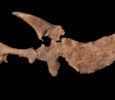Half Triceratops Skull
Half Triceratops Skull
Late Cretaceous Period, C. 68-66 Million Years Ago, USA
Fossilised Bone
97.8 x 59 x 218 cm
Sold
A partial skull of a fully grown Triceratops prorsus from the Maastrichtian, late Cretaceous period (68-65 million years ago). It is in three parts, and has an impressively sized nasal and arching brow horn (90.17 cm long) and frill. The impressive dimensions of this specimen dramatically evokes the overwhelming size and presence of the prehistoric beast.
The triceratops roamed the plains of what is now North America around 68-66 million years ago. It was the most numerous of the horned cretaceous dinosaurs as well as the largest ceratopsian, and one of the last to become extinct approximately 66 million years ago.
One of the most famous species of dinosaur, its flaring bony frill, pointed beak and three-horned head make the triceratops instantly recognisable. Today two species of triceratops are accepted: the earlier T. horridus, which is characterised by a smaller nose horn and long beak, and the later T. prorsus, with its longer nose horn and shorter beak. Adult triceratops weighed around 7 to 12 tonnes, roughly the equivalent of 7 small cars, and larger than a full-grown African elephant.
A herbivore, the triceratops grazed on the plentiful low-lying plants of its lush habitat. Its head was up to one-third the length of its body and is the largest known skull of any land animal. Its menacing horns were largely for protection, as triceratops lived contemporaneously with the Tyrannosaurus rex and, as the largest herbivore, most likely made up the majority of its prey. The flaring frill was ostensibly also for protection although studies have shown it may have originally been brightly coloured, suggesting possible functions ranging from mating rituals, identification purposes, and even regulating body temperature. Many skulls found have been damaged in what appear to be predator attacks, and examples have even been found with tyrannosaur tooth marks and new growth after breakage.
Sculpted by Nature: Fossils, Minerals and Meteorites, Christie’s, Online, 10-24 May 2023, Lot 9.
Discovered on private land, Garfield County, Montana, USA, 2017.
ALR: S00236272, with IADAA Certificate, this item has been checked against the Interpol database.










 Enquire
Enquire




